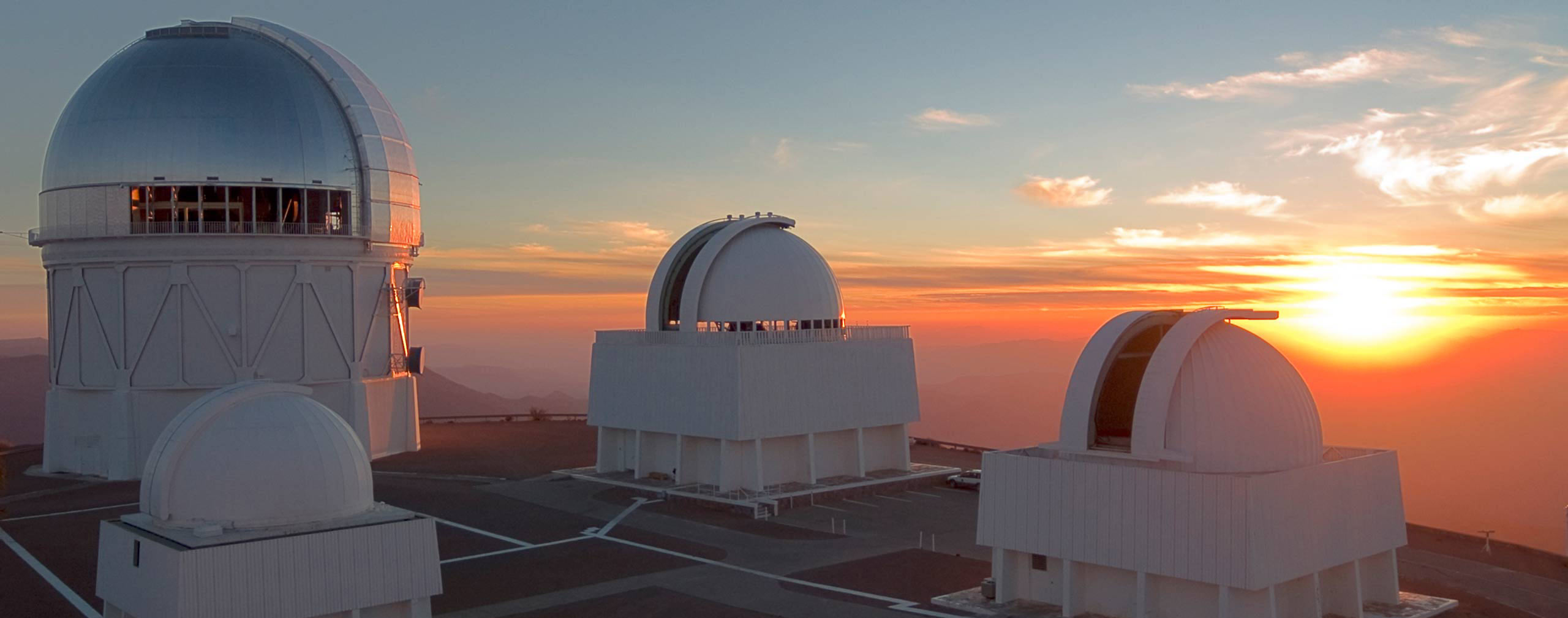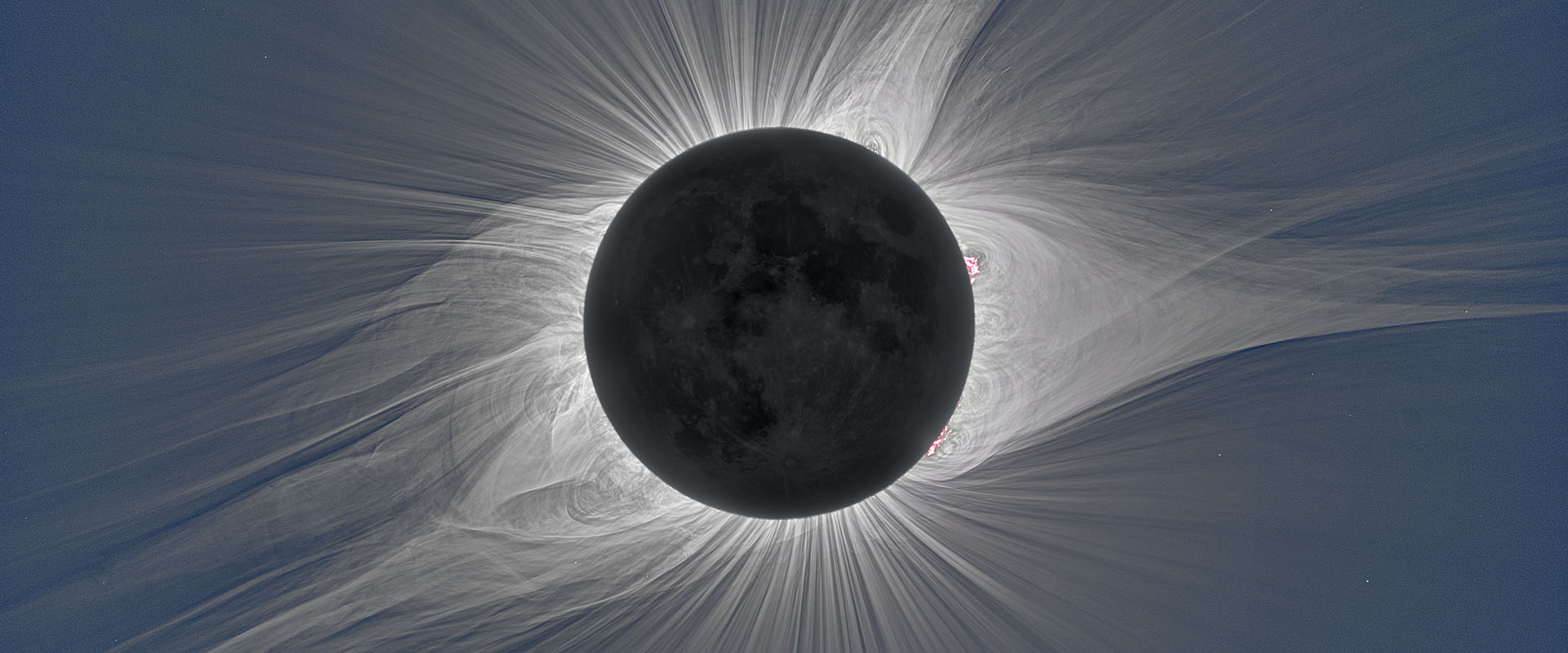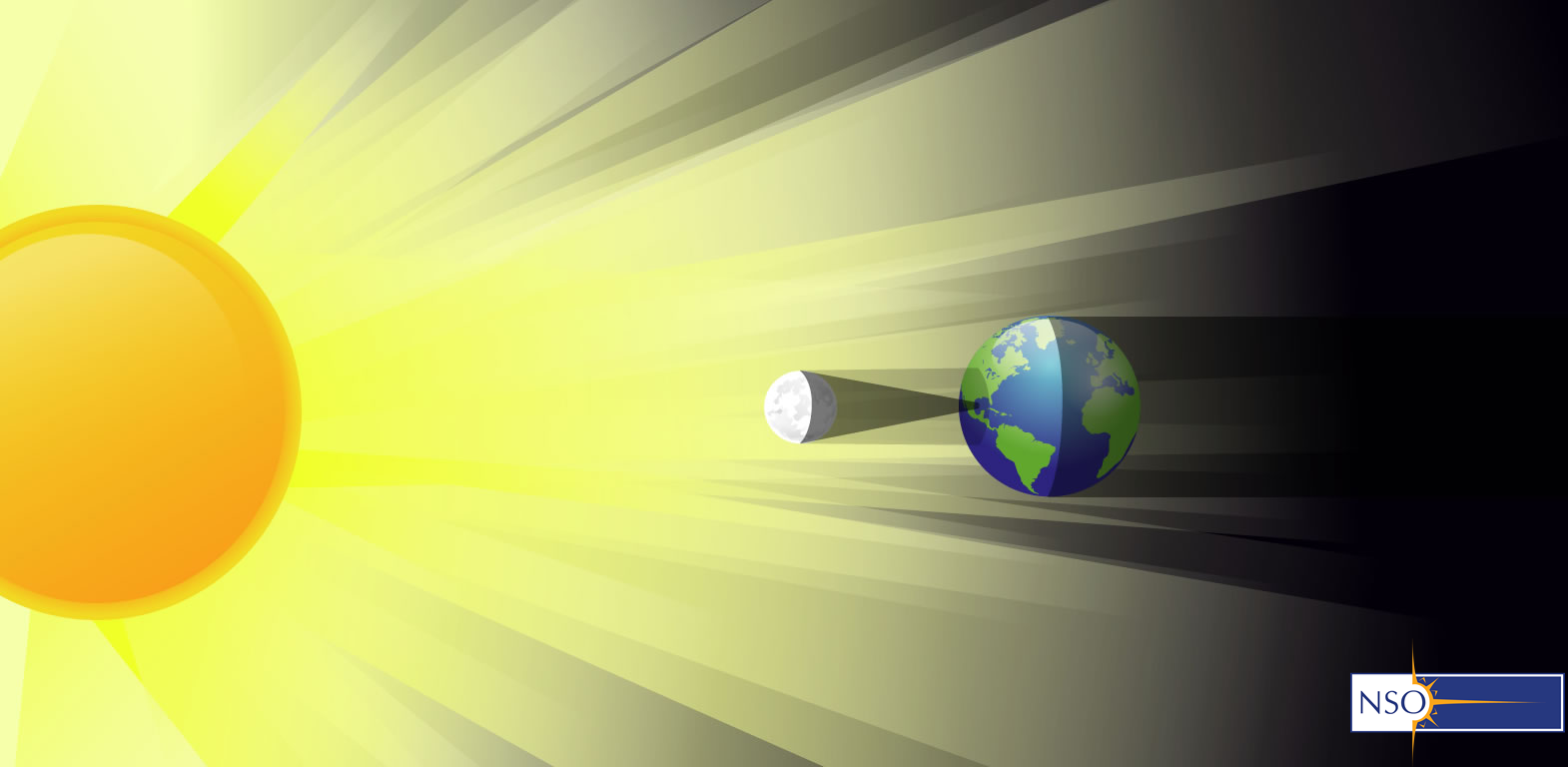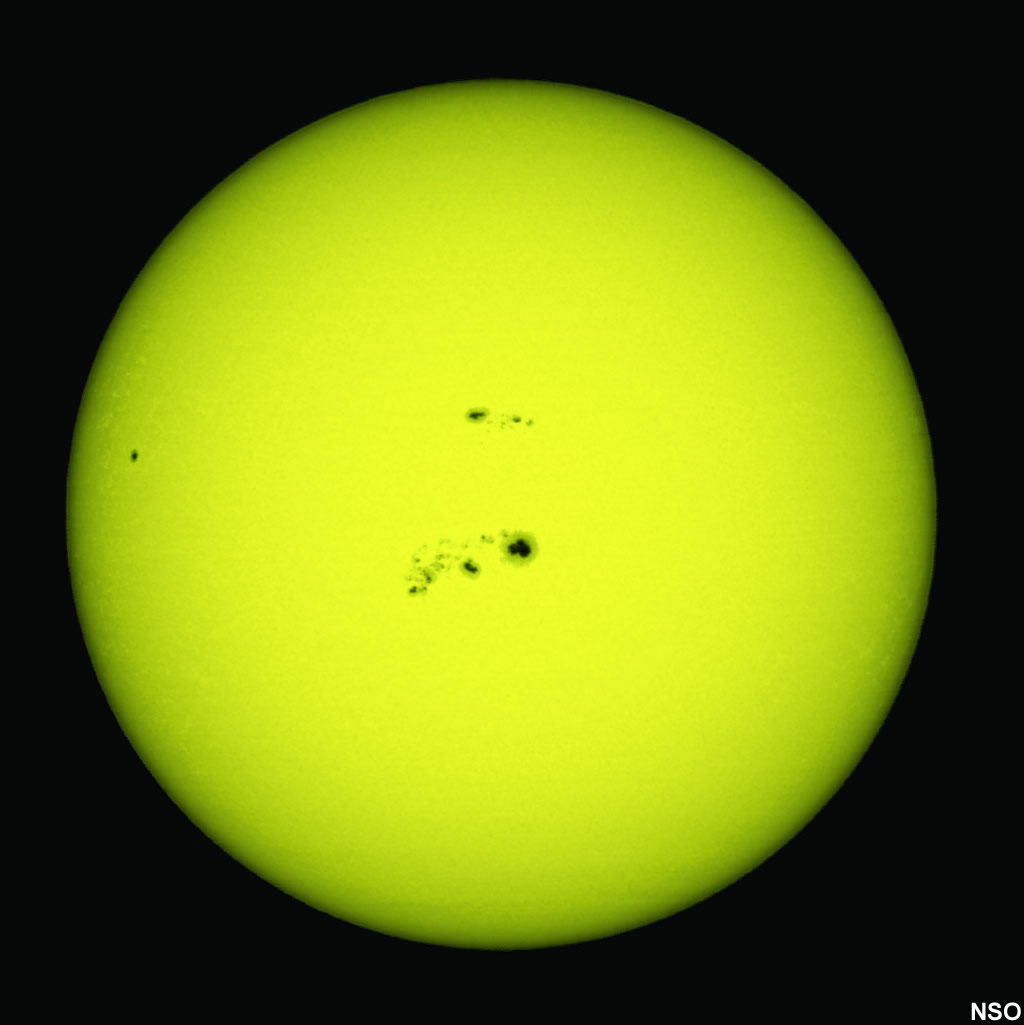A Stroke of Astronomical Luck for Solar Science
 Cerro Tololo Inter-American Observatory at Sunset Credit: NSO/AURA/NSF
Cerro Tololo Inter-American Observatory at Sunset Credit: NSO/AURA/NSF
Scientists plan for an eclipse over NSF’s observatory in Chile
By Shari Lifson
On July 2, 2019 a total solar eclipse will pass over Chile and Argentina, and through a stroke of astronomical luck, the path of totality crosses directly over the National Science Foundation’s (NSF) Cerro Tololo Inter-American Observatory located in the foothills of the Andes, 7,241 feet (2200 meters) above sea level in the Coquimbo Region of northern Chile. Five science teams chosen by NSF’s National Solar Observatory will perform experiments at Cerro Tololo during the eclipse; four of them will have their equipment trained on the Sun’s elusive corona and one will study eclipse effects on the Earth itself.
The Sun’s Corona
Throughout history, total solar eclipses have amazed humankind. Many cultures’ eclipse myths and legends portray them as divine, fortuitous or even ominous events. Today we understand the science behind why total solar eclipses occur. But we can still learn a lot about the Sun during the brief minutes of totality, when the Sun is completely blocked by the Moon. For scientists, a total solar eclipse offers a rare opportunity to study a part of the Sun they don’t normally see, its inner corona.
The corona is a region of magnetism and extraordinarily hot gasses that makes up the outermost part of the Sun’s atmosphere. It has mysterious properties we have yet to understand, like why it is extremely hot, hotter than the surface of the Sun. It is especially difficult to study because it is less dense and millions of times dimmer than the visible disk of the Sun and thus hard to see in the sun’s full glare. However, when the bright disk of the Sun is completely covered by the Moon, as in a total solar eclipse, we can see its corona shining.
Scientists study the corona because it is important for predicting space weather, a phenomena that can potentially damage our electrical grids, telecommunications and satellites. Space weather occurs when the Sun occasionally spews magnetic plumes called coronal mass ejections into space. If one of those plumes is aimed at Earth, we could experience electrical and telecommunication disruptions like the super solar storm of 1859 known as the Carrington event, that burned up telegraph wires around the world. Such magnetic storms carry a much greater risk today in our electronically connected and dependent world.
Each of the following five science teams are taking advantage of the 2 minutes and 6 seconds of totality on Cerro Tololo to increase our understanding of the Sun’s mysteries and its impact on Earth.
 The Sun’s corona shining brightly during a total solar eclipse. Credit: ©2009 Miloslav Druckmüller, Peter Aniol, Vojtech Rušin, Ľubomír Klocok, Karel Martišek, Martin Dietzel
The Sun’s corona shining brightly during a total solar eclipse. Credit: ©2009 Miloslav Druckmüller, Peter Aniol, Vojtech Rušin, Ľubomír Klocok, Karel Martišek, Martin Dietzel
Observations Over 20 Plus Years
An international team led by Jay Pasachoff (Williams College) will image the Sun’s corona as a continuation of an experiment started in the 1990s. The experiment will measure the corona’s current color, shape, and temperature.
Pasachoff explained why he has been doing this experiment for so many years, “The Sun varies from day to day, and also over the 11-year solar cycle. Each glimpse we get of the Sun during a total solar eclipse—only a couple of minutes every 18 months or so—gives us a different set of features to look at. One of our interests is understanding the eruptions on the Sun that could damage all the satellites now orbiting the Earth, so when we measure the speeds of the coronal mass ejections we sometimes see at eclipses, our work has potential major security implications for us on Earth.”
The location of the large coronal structures called streamers – pointy regions that appear in most images of the corona is known for – vary throughout the solar cycle. The 2019 eclipse occurs during a minimum of the 11-year solar cycle, a time when solar eruptions are infrequent and the Sun appears to be calm. Eclipses taking place near solar-cycle minimum, like this one, will provide Pasachoff’s team with a rare view of solar polar plumes – tufts of open magnetic field that emanate from the solar north and south poles, which are hidden from our view by high-latitude streamers at other eclipses. “I’m also looking forward to comparing our observations of the corona taken during the eclipse (and combined in computers subsequently) with predictions that colleagues make before the eclipse based on the Sun’s magnetic field and sunspots over the preceding month,” explains Pasachoff.
The corona’s overall temperature also changes with the 11-year sunspot cycle. The team will use observations of superheated iron to follow the overall temperature of the corona over the sunspot cycle.
Pasachoff added, “We are hopeful that observing from the 7,241 feet (2,200 meters) high altitude of NSF’s Cerro Tololo Inter-American Observatory will give us an especially clear view of the corona.”
The Solar Wind Sherpas from Hawai’i
Shadia R. Habbal (University of Hawai’i) will be leading an international team called the “Solar Wind Sherpas” that will study the Sun’s corona from three different locations across South America. The sites include Cerro Tololo and two locations in Argentina.
The team successfully used this multi-site observing strategy during the August 21, 2017 total solar eclipse over the United States, with five observing sites spanning 1,200 miles (1,931 kilometers). The strategy, with identical instruments at each site, maximizes the chances for observations in the event of poor weather at any one site. It also allows the teams to track changes in coronal structures that occur over a very short timescale. The team’s goal for 2019 is to increase the suite of imagers and spectrometers used in 2017, and to include additional wavelengths of light which have not been observed so far.
Habbal explained, “We will explore the physics of the solar corona through imaging and spectroscopy (breaking up the light into its component wavelengths). We have a number of telescope systems with special filters to isolate emission from different elements in the corona, mainly iron, argon and nickel. Our spectrometers will enable us to detect motions in the corona. Our white light images will yield very high spatial resolution images of all coronal structures.”
Multi-wavelength imaging and spectroscopic measurements can detect the chemical composition, temperature, density, non-thermal motions and outflows of the different parts of the corona. These measurements allow the team to explore the dynamics and thermodynamics of the corona close to the solar surface. This is the region of the corona where the largest changes in the solar magnetic field occurs, and where the solar wind and coronal mass ejections originate and accelerate.
This eclipse will be unique, Habbal said, “because it occurs late in the afternoon and the Sun will be at very low altitude. Also, the Sun is close to solar minimum, so the distribution of structures in the solar corona will be different from 2 years ago (2017).”
Citizen Science from Japan
Yoichiro Hanaoka’s team from the Solar Science Observatory of National Astronomical Observatory of Japan is also undertaking multi-site observations in Chile and Argentina. This team will be performing observations of the corona close to the surface of the Sun that will fill in an area not visible to spaceborne observatories like NASA’s LASCO and STEREO coronagraphs. Hanaoka will then combine the data of both space and ground-based observations to construct a complete image of the corona.
Hanaoka commented, “We are going to collaborate with amateur observers, widely spread along the total eclipse path in Chile and Argentina, to organize multi-site observations. By combining all of these observations, we can trace the time variations of the corona. It will be a great achievement for citizen science.”
UCAR Team Explores Magnetic Fields
A team led by UCAR researcher Paul Bryans will investigate the magnetic field of the Sun’s corona. Magnetic structures in the corona play a fundamental role in causing the explosive events that contribute to space weather and its effects on the Earth. Measuring the orientation of the magnetic field can help in understanding the Sun-Earth system, and ultimately aid in predicting what drives space weather events. Reliable measurements of the magnetic field in the corona are, however, among the most challenging problems of observational solar physics.
Bryans explained how he is planning on taking these measurements during the eclipse, “If we measure the intensity, or brightness, of the light coming from the Sun then we can tell many things about it – how hot it is, how dense. But the only way to measure the magnetic field is to measure the polarization of the light. We will do this at the eclipse by using polarizers on our telescope. They work in exactly the same way as sunglasses, blocking light that is polarized in a certain direction. By rotating these polarizers, we can piece together the shape of the magnetic field on the Sun. This will help us understand what types of magnetic field configurations can lead to eruptive events.”
Studying the Corona in the Future
“On July 2, NSF funding will enable scientists to seize the precious opportunity of a total solar eclipse to study the Sun’s corona,” explained NSF Program Director David Boboltz, “But next year, scientists will no longer have to wait for an eclipse to engage in cutting-edge research. NSF’s Daniel K. Inouye Solar Telescope, which begins operations in 2020, will allow direct imaging of the solar corona anytime, shedding light on fundamental questions regarding solar magnetic fields and the heating to over a million degrees of the coronal plasma.”
 Illustration of the Moon’s shadow during an eclipse Credit: NSO/AURA/NSF
Illustration of the Moon’s shadow during an eclipse Credit: NSO/AURA/NSF
Changes on Earth during a Total Solar Eclipse
One team won’t be observing the Sun’s corona during the total solar eclipse but instead will be monitoring changes happening here on Earth. M. Serra-Ricart’s team, from the Institute of Astrophysics of the Canary Islands, will observe changes in the Earth’s atmosphere including drops in temperature and charging of the ionosphere, the layer of the Earth’s atmosphere that makes long-distance radio reception possible at night.
M. Serra-Ricart explained, “A total solar eclipse produces a broad, round area of darkness and greatly reduced sunlight that travels across Earth’s atmosphere in a relatively narrow path during the daytime. Its effect on solar radiation intensity is remarkably similar to what happens at sunrise and sunset and it creates changes in the Earth’s atmosphere we want to measure.”
Observers of total solar eclipses feel the dramatic temperature drop when the Sun is completely covered by the Moon. The team will track how much and how fast the temperature changes during the eclipse on Cerro Tololo. They will also track changes in the ionosphere to better understand how it impacts nighttime long distance radio reception.
“The loss of sunlight due to the passage of the shadow of the moon during the eclipse is going to briefly produce a night-time like ionosphere. But it is considerably different than ordinary night-time. The moon’s shadow is relatively small on the Earth and travels at supersonic speeds. It will likely produce some interesting effects that might be detectable on ordinary radios or small receivers.” added M. Serra-Ricart. “Although the ionospheric effects of solar eclipses have been studied for over 50 years many unanswered questions remain. We know roughly how this happens, but not precisely. The eclipse will give researchers a chance to examine the charging and uncharging process in almost real time.”
In addition to the science experiments, the team will also transmit a live video feed of the eclipse on YouTube Live, FaceBook, and Periscope.
About Cerro Tololo
Cerro Tololo Inter-American Observatory (CTIO) is a complex of astronomical telescopes and instruments located at 30.169 S, 70.804 W, approximately 80 km to the East of La Serena, Chile, at an altitude of 2200 metres. The complex is part of the National Optical Astronomy Observatory (NOAO) along with Kitt Peak National Observatory (KPNO) in Tucson, Arizona. The principal telescopes are the 4-m Victor M. Blanco Telescope and the 4.1-m Southern Astrophysical Research (SOAR) telescope, dedicated in April of 2004. The NOAO is operated by the Association of Universities for Research in Astronomy (AURA), which also operates the Space Telescope Science Institute and the Gemini Observatory. One of the two 8-m telescopes comprising the Gemini Observatory is co-located with CTIO on AURA property in Chile. The National Science Foundation (NSF) is the funding agency for NOAO. The Observatory headquarters are located in La Serena, Chile, about 300 miles north of Santiago.
About The National Solar Observatory
The National Solar Observatory (NSO) is the national center for ground-based solar physics in the United States (www.nso.edu) and is operated by the Association of Universities for Research in Astronomy (AURA) under a cooperative agreement with the National Science Foundation Division of Astronomical Sciences.
About AURA
The Association of Universities for Research in Astronomy (AURA) is a consortium of 46 US institutions and 4 international affiliates that operates world-class astronomical observatories for the National Science Foundation and NASA. AURA’s role is to establish, nurture, and promote public observatories and facilities that advance innovative astronomical research. In addition, AURA is deeply committed to public and educational outreach, and to diversity throughout the astronomical and scientific workforce. AURA carries out its role through its astronomical facilities.
AURA is responsible for the successful management and operation of its five centers: the Gemini Observatory; the Large Synoptic Survey Telescope (LSST); the National Optical Astronomy Observatory (NOAO); the National Solar Observatory (NSO); and the Space Telescope Science Institute (STScI).
The National Science Foundation (NSF) is an independent federal agency created by Congress in 1950 to promote the progress of science. NSF supports basic research and people to create knowledge that transforms the future. Please refer to www.nsf.gov.
Contacts:
National Solar Observatory
Claire Raftery
craftery@NSO.edu
Cerro Tololo Eclipse Team
Manuel Paredes
mparedes@gemini.edu
Mark Newhouse
newhouse@noao.edu
AURA
Shari Lifson
slifson@aura-astronomy.org


